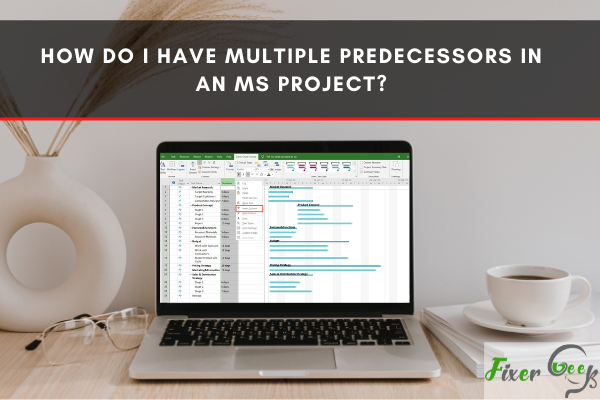- How to Add Multiple Predecessors in MS Project?
- Definition of MS Project’s Predecessor
- Basic Steps to Integrate Predecessors
- Standard Approaches to Introduce Predecessors
- Method 01: Visualized Task Path with Predecessors in the Gantt Chart
- Method 02: Visualized Predecessor in Work Breakdown Structure
- Summary: Do I have multiple predecessors in an MS Project
There might come a time when a predecessor of one task in an MS Project schedule is the same as a predecessor of another task. In these cases it is normal to have many predecessors on a task. This tutorial shows an example of how this could happen in an MS Project schedule and how to change it through the use of predecessors that are blocks.

Recent upgrades in MS project enables extensive support throughout project management. And one practical way to ease the tasks, concerning driving predecessors.
You’re to define Predecessors for every Successor to understand the effects. It’s sure to help with the eventual determination of the gaps, chances & further improvements.
How to Add Multiple Predecessors in MS Project?
Definition of MS Project’s Predecessor
It’s one definite task to drive its successor steps (tasks) before the implementation or completion. Different projects come with immense variation in their complexity. And one single task can get interlinked to multiple predecessors.
So you can think of this feature in a hierarchical way where the upcoming task will follow the footprints of one or more completed tasks.
Using the MS project, it becomes easy to locate all the predecessors with some basic knowledge. The software integrates some featureful tools to help with the process. You can immediately determine the order of influential predecessors.
Basic Steps to Integrate Predecessors
Though it comes pretty simple, the approach fits only a limited number of projects. It seems worthy for implementations with minimal resources, steps & complexity. But the details should help you to improvise the idea in the future.
- Open the ‘Task Sheet View’.
- Keep scrolling till you find the ‘Add Column’ option.
- Add the necessary columns to define Successor & Predecessor.
- Don’t forget to add columns featuring task start & end dates.
- Introduce one singular ‘Project Start Date’ task at the top side.
- Keep inserting the ‘Task Name’ & ‘Task Duration’ for every task.
- Check the task settings to ensure ‘Auto Schedule’ is turned on.
- Start adding the Predecessors & Successors through task IDs.
- Cross-check the insertions to have Predecessors for Successors.
Standard Approaches to Introduce Predecessors
As you can notice, the basic idea appears more like a simplified example. It gets challenging to continue with the steps for larger, heavier project works.
Apart from the aforementioned process, you’re to utilize the upgraded method. Not to mention, there are two convenient ways to introduce driving predecessors.
Method 01: Visualized Task Path with Predecessors in the Gantt Chart
Graphical presentation in MS Project specifically means Gantt chart integration. You’ll have to utilize the ‘Highlighting Options’ under its ‘Task Path’.
The facilitation works exceptionally satisfying for somewhat simpler projects. It lets you handle a limited number of tasks concerning the predecessors.
Method 02: Visualized Predecessor in Work Breakdown Structure
Too much line in the schedule makes the first option obsolete in most of the complicated cases. The method implies ‘Inspect’ under the ‘Task’ ribbon.
Whether your project remains complex or simple – you can keep the method under consideration. An enlisting pan will reveal the effect of every predecessor.
Check out the Driving Predecessors in MS Project guidelines to understand both methods closely.
The introduction of the predecessor is one great feature to help with your project management. It lets you figure out the interconnections in terms of efficiency. Adding multiple driving predecessor comes relatively easy for anyone. You just need to explore the usability of available approaches.
Summary: Do I have multiple predecessors in an MS Project
- In MS Project, you can assign multiple predecessors to a single task.
- You can also use the predecessor column to create a link between two tasks that are on different levels in the WBS (Work Breakdown Structure).
- A Finish to Start Task Dependency is the most common and standard dependency used in scheduling.
- In a Finish-to-Start relationship, task B cannot start until task A finishes.
- Each task should be assigned a link type to all of its predecessors.
- Linking of tasks should be done from top to bottom so that each task is linked to its predecessor.
- Links are created in MS Project based on activity priortization and the flow of work.
- Avoid breaking logical network sequence by linking the predecessor tasks to their successor tasks.
- Different project management software programs offer different methodologies for creating links between activities or tasks.
- To make sure your schedule fits together, it is important to understand how you set up the links between your activities or tasks.
- MS project allows you to create multiple predecessors, but you should only do this if it makes sense for your project.